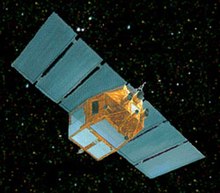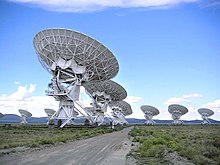GRB 970508
UTC May 8, 1997 | |
| Constellation | Camelopardalis |
|---|---|
| Right ascension | 06h 53m 49s[1] |
| Declination | +79° 16′ 19.6″[1] |
| Distance | 6,000,000,000 ly (1.8×109 pc) |
| Redshift | 0.835 ≤ z ≤ 2.3 |
| Peak apparent magnitude | 19.6 |
| Total energy output | 5 × 1050 erg (5 × 1043 J) |
| Other designations | GRB 970508 |
| | |
| ] | |
GRB 970508 was a
A gamma-ray burst is a highly
GRB 970508 was detected by the Gamma Ray Burst Monitor on the Italian–Dutch
Until this burst, astronomers had not reached a consensus regarding how far away GRBs occur from Earth. Some supported the idea that GRBs occur within the Milky Way, but are visibly faint because they are not highly energetic. Others concluded that GRBs occur in other galaxies at cosmological distances and are extremely energetic. Although the possibility of multiple types of GRBs meant that the two theories were not mutually exclusive, the distance measurement unequivocally placed the source of the GRB outside the Milky Way, effectively ending the debate.
GRB 970508 was also the first burst with an observed radio frequency afterglow. By analyzing the fluctuating strength of the radio signals, astronomer Dale Frail calculated that the source of the radio waves had expanded almost at the speed of light. This provided strong evidence that GRBs are relativistically expanding explosions.
Discovery

A gamma-ray burst (GRB) is a highly
On Thursday May 8, 1997, at 21:42 UTC, BeppoSAX's Gamma Ray Burst Monitor registered a gamma-ray burst that lasted approximately 15 seconds.
Observations

After a rough position of the burst had been determined,
The following evening Djorgovski again observed the region. He compared the images from both nights but the error box contained no objects that had decreased in luminosity between May 8 and May 9.
After discovering the burst's X-ray afterglow, the BeppoSAX team provided a more accurate localization, and what Metzger had assumed to be a variable star was still present in this smaller error box. Both the Caltech team and the Amsterdam team were hesitant to publish any conclusions on the variable object. On May 10
On the night between May 10 and May 11, 1997, Metzger's colleague
On May 13, five days after the first detection of GRB 970508, Frail resumed his observations with the Very Large Array.[21] He made observations of the burst's position at a wavelength of 3.5 cm and immediately detected a strong signal.[21] After 24 hours, the 3.5 cm signal became significantly stronger, and he also detected signals at the 6 and 21 cm wavelengths.[21] This was the first confirmed observation of a radio afterglow of a GRB.[21][22][23]
Over the next month, Frail observed that the luminosity of the radio source fluctuated significantly from day to day but increased on average. The fluctuations did not occur simultaneously along all of the observed wavelengths, which Jeremy Goodman of Princeton University explained as being the result of the radio waves being bent by interstellar plasma in the Milky Way.[22][24] Such radio scintillations (rapid variations in the radio luminosity of an object) occur only when the source has an apparent diameter of less than 3 microarcseconds.[24]
Characteristics
BeppoSAX's Gamma-Ray Burst Monitor, operating in the energy range of 40–700
About 5 hours after the burst the apparent magnitude of the object—a logarithmic measure of its brightness with a higher number indicating a fainter object—was 20.3 ± 0.3 in the U-band (the ultraviolet region of the spectrum) and 21.2 ± 0.1 in the R-band (the red region of the spectrum).[20] The afterglow reached its peak luminosity in both bands approximately 2 days after the burst was first detected—19.6 ± 0.3 in the U-band at 02:13 UTC on May 11, and 19.8 ± 0.2 in the R-band at 20:55 UTC on May 10.[20]
James E. Rhoads, an astronomer at the Kitt Peak National Observatory, analyzed the burst and determined that it was not strongly beamed.[26] Further analysis by Frail and his colleagues indicated that the total energy released by the burst was approximately 5×1050 ergs (5×1043 J), and Rhoads determined that the total gamma-ray energy was approximately 3×1050 erg (3×1043 J).[27] This implied that the gamma-ray and kinetic energy of the burst's ejecta were comparable, effectively ruling out those GRB models which are relatively inefficient at producing gamma rays.[27]
Distance scale and emission model

Prior to this burst, astronomers had not reached consensus regarding how far away GRBs occur from Earth. Although the
Throughout the month of May the radio scintillations became less noticeable until they ceased altogether. This implies that the radio source significantly expanded in the time that had passed since the burst was detected. Using the known distance to the source and the elapsed time before the scintillation ended, Frail calculated that the radio source had expanded at almost the speed of light.[29] While various existing models already encompassed the notion of a relativistically expanding fireball, this was the first strong evidence to support such a model.[30][31]
Host galaxy
The afterglow of GRB 970508 reached a peak total luminosity 19.82 days after the burst was detected. It then faded with a
See also
Notes
- ^ a b Djorgovski 1997
- ^ Schilling 2002, pp. 12–16
- ^ Costa 1997
- ^ Schilling 2002, pp. 58–60
- ^ Pedersen 1997
- ^ a b Schilling 2002, pp. 115–116
- ^ Pian 1998
- ^ a b Kouveliotou 1997
- ^ a b Schilling 2002, pp. 116–117
- ^ a b c Schilling 2002, pp. 118–120
- ^ Bond 1997
- ^ a b Schilling 2002, pp. 121–123
- ^ Varendoff 2001, p. 383
- ^ a b Metzger 1997a
- ^ a b Metzger 1997b
- ^ Katz 2002, p. 148
- ^ Katz 2002, p. 149
- ^ Schilling 2002, p. 120
- ^ Reichart 1998
- ^ a b c Castro-Tirado 1998
- ^ a b c d Schilling 2002, p. 124
- ^ a b Katz 2002, p. 147
- ^ NRAO 1997
- ^ a b Schilling 2002, p. 125
- ^ Galama 1998
- ^ Rhoads 1999
- ^ a b Paczyński 1999, p. 2
- ^ Schilling 2002, p. 123
- ^ Waxman 1998
- ^ Schilling 2002, p. 126
- ^ Piran 1999, p. 23
- ^ a b c d Fruchter 2000
- ^ Bloom 1998
References
- Bloom, J. S.; Djorgovski, S. G.; Kulkarni, S. R.; Frail, D. A. (1998-11-01). "The Host Galaxy of GRB 970508" (PDF). The Astrophysical Journal. 507 (1). California Institute of technology: L25–L28. S2CID 18107687. Retrieved 2009-03-15.
- Bond, H. E. (1997). "IAU Circular 6654: 1997cm; GRB 970508". International Astronomical Union. Retrieved 2011-07-05.
- Castro-Tirado, A. J.; Gorosabel, Javier; Benitez, Narciso; Wolf, Christian; Fockenbrock, Ralf; Martinez-Gonzalez, Enrique; Kristen, Helmuth; Broeils, Adrick; Pedersen, Holger; Greiner, Jochen; Costa, Enrico; Feroci, Marco; Piro, Luigi; Frontera, Filippo; Nicastro, Luciano; Palazzi, Eliana; Bartolini, Corrado; Guarnieri, Adriano; Masetti, Nicola; Piccioni, Adalberto; Mignoli, Marco; Wold, Magrethe; Lacy, Mark; Birkle, Kurt; Broadhurst, Tom; Brandt, Soen; Lund, Niels (1998-02-13). "Photometry and Spectroscopy of the GRB 970508 Optical Counterpart". Science. 279 (5353): 1011–1014. PMID 9461429.
- Costa, E.; Frontera, F.; Heise, J.; Feroci, M.; In 't Zand, J.; Fiore, F.; Cinti, M. N.; Dal Fiume, D.; Nicastro, L.; Orlandini, M.; Palazzi, E.; Rapisarda, M.; Zavattini, G.; Jager, R.; Parmar, A.; Owens, A.; Molendi, S.; Cusumano, G.; MacCarone, M. C.; Giarrusso, S.; Coletta, A.; Antonelli, L. A.; Giommi, P.; Muller, J. M.; Piro, L.; Butler, R. C. (1997-06-19). "Discovery of an X-ray afterglow associated with the γ-ray burst of 28 February 1997". Nature. 387 (6635): 783–785. S2CID 4260635.
- Djorgovski, S. G.; Metzger, M. R.; Odewahn, S. C.; Gal, R. R.; Kulkarni, S. R.; Pahre, M. A.; Frail, D. A.; Costa, E.; Feroci, M. (1997). "IAU Circular 6655: GRB 970508". International Astronomical Union. Retrieved 2011-07-05.
- "Very Large Array Detects Radio Emission From Gamma-Ray Burst" (Press release). National Radio Astronomy Observatory. 1997-05-15. Retrieved 2009-04-04.
- Fruchter, A. S.; Pian, E.; Gibbons, R.; Thorsett, S. E.; Ferguson, H.; Petro, L.; Sahu, K. C.; Livio, M.; S2CID 14856861. Retrieved 2009-04-01.
- Galama, T. J.; Groot, P. J.; Van Paradijs, J.; Kouveliotou, C.; Strom, R. G.; Wijers, R. A. M. J.; Tanvir, N.; Bloom, J.; Centurion, M.; Telting, J.; Rutten, R. G. M.; Smith, P.; MacKey, C.; Smartt, S.; Benn, C.; Heise, J.; In't Zand, J. (1998-04-10). "Optical Follow-Up of GRB 970508" (PDF). The Astrophysical Journal. 497 (1): L13–L16. S2CID 118998539. Retrieved 2009-04-04.
- Katz, Jonathan I. (2002). The Biggest Bangs. Oxford University Press. ISBN 978-0-19-514570-0.
- Kouveliotou, C.; Briggs, M. S.; Preece, R.; Fishman, G. J.; Meegan, C. A.; Harmon, B. A. (1997). "IAU Circular 6660: GRB 970508". International Astronomical Union. Retrieved 2011-07-05.
- Metzger, M. R.; Djorgovski, S. G.; Steidel, C. C.; Kulkarni, S. R.; Adelberger, K. L.; Frail, D. A. (1997). "IAU Circular 6655: GRB 970508". International Astronomical Union. Retrieved 2011-07-05.
- Metzger, M. R.; Djorgovski, S. G.; Kulkarni, S. R.; Steidel, C. C.; Adelberger, K. L.; Frail, D. A.; Costa, E.; Frontera, F. (1997b). "Spectral constraints on the redshift of the optical counterpart to the γ-ray burst of 8 May 1997". Nature. 387 (6636): 878–880. doi:10.1038/43132.
- Paczyński, Bohdan (1999). M. Livio; N. Panagia; K. Sahu (eds.). Gamma-Ray Burst–Supernova relation. Supernovae and Gamma-Ray Bursts: The Greatest Explosions Since the Big Bang. ISBN 0-521-79141-3.
- Pederson, H.; Jaunsen, A. O.; Grav, T.; Ostensen, R.; Andersen, M. I.; Wold, M.; Kristen, H.; Broeils, A.; Naslund, M.; Fransson, C.; Lacy, M.; Castro‐Tirado, A. J.; Gorosabel, J.; Rodriguez Espinosa, J. M.; Perez, A. M.; Wolf, C.; Fockenbrock, R.; Hjorth, J.; Muhli, P.; Hakala, P.; Piro, L.; Feroci, M.; Costa, E.; Nicastro, L.; Palazzi, E.; Frontera, F.; Monaldi, L.; Heise, J. (1998). "Evidence for Diverse Optical Emission from Gamma-Ray Burst Sources". The Astrophysical Journal. 496 (1): 311–315. S2CID 16614555.
- Pian, E.; Fruchter, A. S.; Bergeron, L. E.; Thorsett, S. E.; Frontera, F.; Tavani, M.; Costa, E.; Feroci, M.; Halpern, J.; Lucas, R. A.; Nicastro, L.; Palazzi, E.; Piro, L.; Sparks, W.; Castro-Tirado, A. J.; Gull, T.; Hurley, K.; Pedersen, H. (1998-01-10). "Hubble Space Telescope Imaging of the Optical Transient Associated with GRB 970508". The Astrophysical Journal. 492 (2): L103–L106. S2CID 16143935.
- Piran, Tsvi (1999). M. Livio; N. Panagia; K. Sahu (eds.). Fireballs. Supernovae and Gamma-Ray Bursts: The Greatest Explosions Since the Big Bang. ISBN 0-521-79141-3.
- Reichart, Daniel E. (1998-02-19). "The Redshift of GRB 970508". Astrophysical Journal Letters. 495 (2). University of Chicago: L99–L101. S2CID 119394440.
- Rhoads, James E. (1999-03-25). "The Dynamics and Light Curves of Beamed Gamma Ray Burst Afterglows". The Astrophysical Journal. 525 (2): 737–749. S2CID 15557456.
- Schilling, Govert (2002). Flash! The hunt for the biggest explosions in the universe. Cambridge: Cambridge University Press. ISBN 978-0-521-80053-2.
- Varendoff, Martin (2001). "Gamma-Ray Bursts". In Volken Schönfelder (ed.). The Universe in Gamma Rays. Springer. pp. 367–396. ISBN 978-3-540-67874-8.
- Waxman, E.; Kulkarni, S. R.; Frail, D. A. (1998-04-10). "Implications of the Radio Afterglow from the Gamma-Ray Burst of 1997 May 8". Astrophysical Journal. 497 (1): 288–293. S2CID 119438251.
